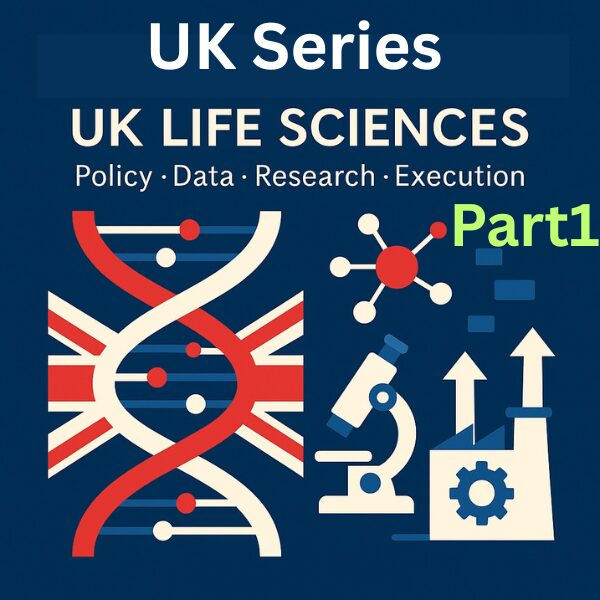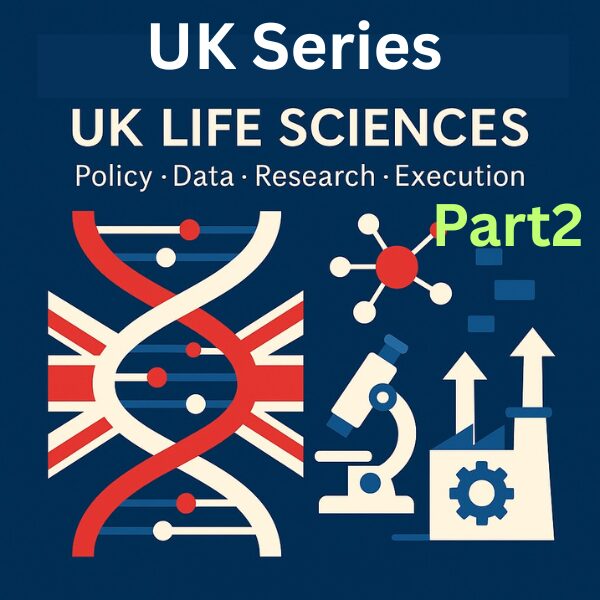Executive Summary|The UK’s edge lies in its public data infrastructure. With ~490k whole-genome sequences (WGS) extending into non-coding, rare variants, and structural variation—and a multi-ancestry GWAS program (Pan-UK Biobank)—the ecosystem elevates causal resolution and portability. The UKB Research Analysis Platform (RAP) and open portals enable secure, at-source analytics, while Genomics England and Our Future Health complement UKB to support target validation, safety, stratification, and repurposing.
1) The Three Pillars of the UK Data Estate
- UK Biobank (UKB): Broad phenotypes, lifestyle, imaging, biospecimens, plus WGS; analyses run in a secure cloud environment.
- Genomics England (GEL): Clinically anchored genomics (rare disease/oncology) with proximity to NHS implementation.
- Our Future Health (OFH): A prevention-first cohort that complements UKB from the public-health angle.
Together they form a longitudinal, translational data spine from research to clinical and preventive care.
2) The Case for UKB WGS: Precision from Breadth
2.1 Coverage and Scale
- Scale: ~490,000 participants sequenced at >30× mean depth.
- Variant landscape: On the order of billions of variants, far beyond array/WES reach.
2.2 Non-Coding, Rare, and Structural Variation
- Non-coding: Regulatory rare variants can shift disease risk and drug response; functional annotation tightens target hypotheses.
- Rare variants: Natural “human knockouts” sharpen efficacy and safety priors for targets.
- Structural variants (SVs): CNVs/indels/translocations often explain phenotypes missed by panel-based approaches.
2.3 Multimodal Linkage
- EHR, prescriptions, labs: Longitudinal real-world signals reinforce causal inferences.
- Imaging and -omics: From variant to pathway to phenotype, integrated at scale.
3) Pan-UK Biobank: Fairness and Portability by Design
3.1 Why Multi-Ancestry
- Diversity: Effect sizes and risks can be ancestry-skewed; multi-ancestry models improve causal localization and generalization.
- PRS portability: Scores trained only in Europeans degrade elsewhere; diverse training improves fairness and transportability.
3.2 Resolution and Fine-Mapping
- Fine-mapping: Leverages LD differences to narrow causal candidates.
- Ancestry-enriched effects: Supports stratified medicine and response prediction.
4) Doing the Work: RAP and Open Portals
4.1 RAP (Research Analysis Platform)
- Analysis-in-place: Secure, cloud-hosted analysis with data remaining inside the environment.
- Tooling: Jupyter/Spark/BigQuery-class tooling for scalable genome–phenome analytics.
4.2 Open Portals
- Allele frequency browsers: Rapid context for rare variants.
- GWAS catalogs / PheWAS: Cross-phenotype signals to anticipate off-target–like patterns.
- SV summaries: Quick reconnaissance of structural variation and phenotypic links.
5) Pharma-Grade Use Cases
- Target validation: LoF carriers and phenotypes inform early Go/No-Go.
- Biomarker design: Variant-aware stratification trims sample size and timelines.
- Safety anticipation: Natural variation around targets guides on-/off-target risk limits.
- Repurposing: Pleiotropic signals uncover new indications.
6) Governance and Ethics
- Consent and purpose: Clear scope for research use with guardrails on secondary use.
- Privacy: Pseudonymization, access audit, and output checks minimize re-identification risk.
- Equity: Multi-ancestry designs mitigate bias and improve generalizability.
7) A Practical Checklist
- Specify a causal hypothesis (phenotype, pathways, safety priors).
- Define a minimum viable dataset (covariates, exclusions, QC).
- Plan for cross-ancestry validation (transfer/meta/PRS portability).
- Pre-register a RAP analysis plan (compute, security, output governance).
- Close the loop with trial and access strategies (bridge to Parts 3–4).
8) Bridge to Part 3: From Discoveries to Translation
Next we convert WGS and multi-ancestry discoveries into practice—target validation, biomarkers, indication design, and safety—in concrete, pharma-ready workflows.
Up next (Part 3): “From Genomes to Targets: Biomarkers, Stratification, and Repurposing at Scale.” Case snippets included.
This article was edited by the Morningglorysciences team.










Comments